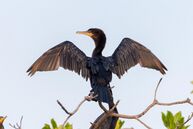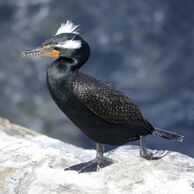Biology:Nannopterum
| American cormorants | |
|---|---|

| |
| Double-crested cormorant (N. auritum) | |
| Scientific classification | |
| Domain: | Eukaryota |
| Kingdom: | Animalia |
| Phylum: | Chordata |
| Class: | Aves |
| Order: | Suliformes |
| Family: | Phalacrocoracidae |
| Genus: | Nannopterum Sharpe, 1899 |
| Type species | |
| Phalacrocorax harrisi Rothschild, 1898
| |
| Species | |
|
N. harrisi | |
| Synonyms | |
|
Nesocarbo | |
Nannopterum is a genus of cormorant comprising three species. They are found throughout the Americas, hence the common name American cormorants.
These species were formerly classified in the genus Phalacrocorax. A molecular phylogenetic study of the cormorants published in 2014 found that these three species formed a clade that was sister to the genus Leucocarbo.[1] To create monophyletic genera, the three species were moved the resurrected genus Nannopterum that had been introduced in 1899 by English ornithologist Richard Bowdler Sharpe to accommodate the flightless cormorant.[2][3][4] The genus Nannopterum is thought to have split from Leucocarbo between 6.7 - 8.0 million years ago.[1]
The genus name Nannopterum combines the Ancient Greek nannos meaning "dwarf" with pteron meaning "wing".[5] This name was coined for the flightless cormorant, which does indeed have small wings. Genetic studies have found that the neotropic and double-crested cormorants form a clade with the flightless cormorant, and they are thus placed together in the genus Nannopterum despite both species having normal-sized wings and full flight capabilities.[4]
List of species
| Image | Scientific name | Common Name | Distribution |
|---|---|---|---|

|
Nannopterum harrisi | Flightless cormorant | Fernandina and Isabela Islands in the Galápagos Islands, Ecuador |

|
Nannopterum brasilianum | Neotropic cormorant | Resident from Tierra Del Fuego north to all of South America, Central America, and Mexico to the Gulf Coast of Texas , along with the southern tip of Baja California, Cuba, and Great Inagua island. Breeding range extends north to most of east-central Texas and central Arizona & New Mexico. Nonbreeding range extends to most of Bahamas. |

|
Nannopterum auritum | Double-crested cormorant | Throughout North America, from Alaska to all of Canada and the United States , south to the Yucatán Peninsula, the Bahamas and Cuba |
References
- ↑ 1.0 1.1 Kennedy, M.; Spencer, H.G. (2014). "Classification of the cormorants of the world". Molecular Phylogenetics and Evolution 79: 249–257. doi:10.1016/j.ympev.2014.06.020. PMID 24994028.
- ↑ Sharpe, Richard Bowdler (1899). A Hand-List of the Genera and Species of Birds. 1. London: Trustees of the British Museum. p. 235. https://www.biodiversitylibrary.org/page/8390434.
- ↑ Chesser, R.T.; Billerman, S.M.; Burns, K.J.; Cicero, C.; Dunn, J.L.; Hernández-Baños, B.E.; Kratter, A.W.; Lovette, I.J. et al. (2021). "Sixty-second Supplement to the American Ornithological Society's Check-list of North American Birds". Ornithology 138 (ukab037). doi:10.1093/ornithology/ukab037.
- ↑ 4.0 4.1 Gill, Frank; Donsker, David; Rasmussen, Pamela, eds (August 2022). "Storks, frigatebirds, boobies, darters, cormorants". IOC World Bird List Version 12.2. International Ornithologists' Union. https://www.worldbirdnames.org/bow/storks/.
- ↑ Jobling, James A. (2010). The Helm Dictionary of Scientific Bird Names. London: Christopher Helm. p. 265. ISBN 978-1-4081-2501-4. https://archive.org/stream/Helm_Dictionary_of_Scientific_Bird_Names_by_James_A._Jobling#page/n265/mode/1up.
Wikidata ☰ Q20719749 entry
 |

